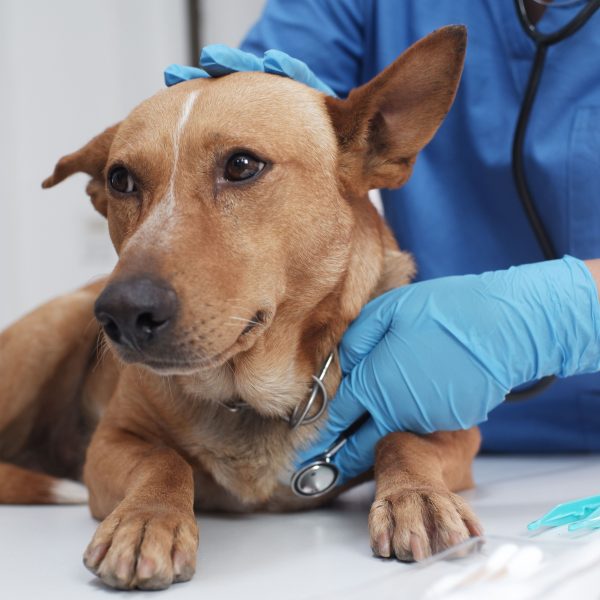Everything You Need to Know About Tapeworms in Dogs

Tapeworms are one of the most common worms found in dogs. These intestinal parasites are flat, segmented worms and are found in dogs, cats, and many other species. Here’s everything you need to know about tapeworms in dogs:
What Are Tapeworms in Dogs?
Tapeworms are flat and segmented worms found in the intestinal tract of dogs. While they are parasites, they’re not in the same family as other intestinal parasites like hookworms and roundworms. There are a few types of tapeworms but the most common type found in dogs is Dipylidium caninum. Tapeworms are one of the most common health problems in dogs.
The tapeworm anchors itself to the wall of the small intestine by using its hook-like mouth. At their longest, adult tapeworms of this species in dogs can grow as long as 11”. As the tapeworm matures, segments (also called proglottids) start to break off from the body of the tapeworm. These segments are then passed from the body with the dog’s feces.
The proglottids look similar to rice grains or cucumber seeds. They are quite small, measuring about 1/2” long and about 1/8” wide. They are commonly seen on the surface of freshly passed feces and sometimes they may be found around the anus. Once the proglottid dries out, it turns a golden color. Eventually, the proglottid breaks open, releasing as many as 20 tapeworm eggs.
What Causes Tapeworms in Dogs?
Tapeworms in dogs are caused when a flea is infected when the tapeworm is ingested. This most often happens if a dog licks their fur and accidentally eats an infected flea. It’s important to know that your dog won’t contract tapeworms just by eating poop (this includes cat poop, as well) containing proglottid packets of fertilized tapeworm eggs. The flea carrying the tapeworm larvae is the direct host when it comes to transmitting tapeworms.
Tapeworms can be a sign your dog has fleas because they can get tapeworms from ingesting a flea while grooming themselves, as well as grooming other dogs or even a cat housemate. Animals like rodents or birds can transmit fleas and this may be another way your dog picks up fleas.
Can Tapeworms be Passed to Humans?
While tapeworms can be passed from dogs to humans, it’s still unlikely. To get a tapeworm from your dog, you would need to swallow an infected flea or any feces carrying tapeworm eggs. Children are actually the most prone to this since they tend to play in grass or other areas where dog waste might be.
How Are Tapeworms in Dogs Diagnosed?
If your dog has tapeworms, you will probably start to notice proglottids in feces and, in some cases, vomit. You may also see your dog dragging their butt against the ground, which is known as scooting.
This is a common dog behavior, but they may be doing it to try and calm irritation caused by the proglottids. You should let your vet know about this behavior. They will be able to officially diagnose your dog with tapeworms if they have them and begin treatment.
How Are Tapeworms in Dogs Treated?
Thanks to effective deworming medications, treating tapeworms is pretty simple. Tapeworms are most often treated with praziquantel, a parasiticide drug that comes in either an oral or injectable form.
Once this medication has been given to your dog, the adult tapeworms begin to detach from the wall of the intestine. After they detach, they are digested in the intestines. Once treatment is complete, you should not see any worms passed in the feces
Praziquantel is available with a prescription from your vet, but there are over-the-counter types, too. However, the most effective tapeworm treatments are prescribed by your veterinarian. There are not usually side effects associated with praziquantel but if any occur, they may include diarrhea, vomiting, lethargy, as well as loss of appetite. These are some symptoms you should never ignore in your dog so you should give your vet a call just in case there’s something else going on.
You may come across home remedies online but none of these are proven to be effective. Since tapeworm medication is so effective and relatively inexpensive, it’s best to talk to your vet and get a prescription instead.
What’s the Prognosis of Tapeworms in Dogs?
Once a dog has gone through a course of treatment, they are usually in the clear. Tapeworms don’t typically cause any further serious health issues in dogs. If a puppy contracts a tapeworm, the problem may be more serious. They can experience stunted growth and anemia. In more severe cases, they may even have intestinal blockages.
How to Prevent Tapeworms in Dogs
Flea prevention is the best way to prevent tapeworms in dogs. The easiest way to protect your dog from fleas is by using flea-preventative measures consistently. Many effective products come in topical and oral forms. You can get preventive treatments either from your vet or over-the-counter.
It’s important to keep a consistent schedule of flea prevention for your dog. This can significantly reduce a flea infestation in your home, which protects your dog. If you have a cat or other animals, make sure to use flea prevention on them, too.
Making sure to dispose of your dog’s feces can help prevent tapeworms. This is especially important in areas like dog parks and is a way to practice good dog park etiquette. You should also try to keep your dog away from garbage and dead animals.
This is everything you need to know about tapeworms in dogs. While it may sound serious, it’s easily treatable and can be prevented with proper flea prevention!
